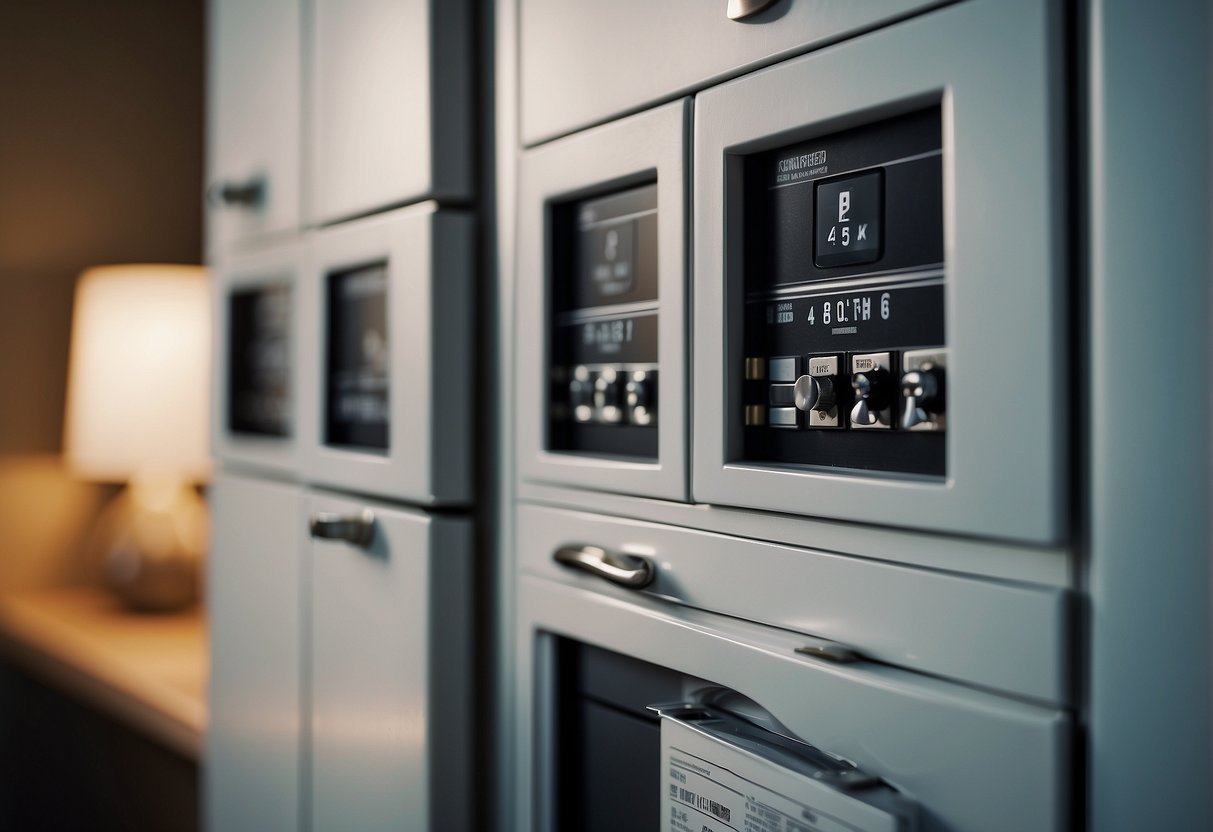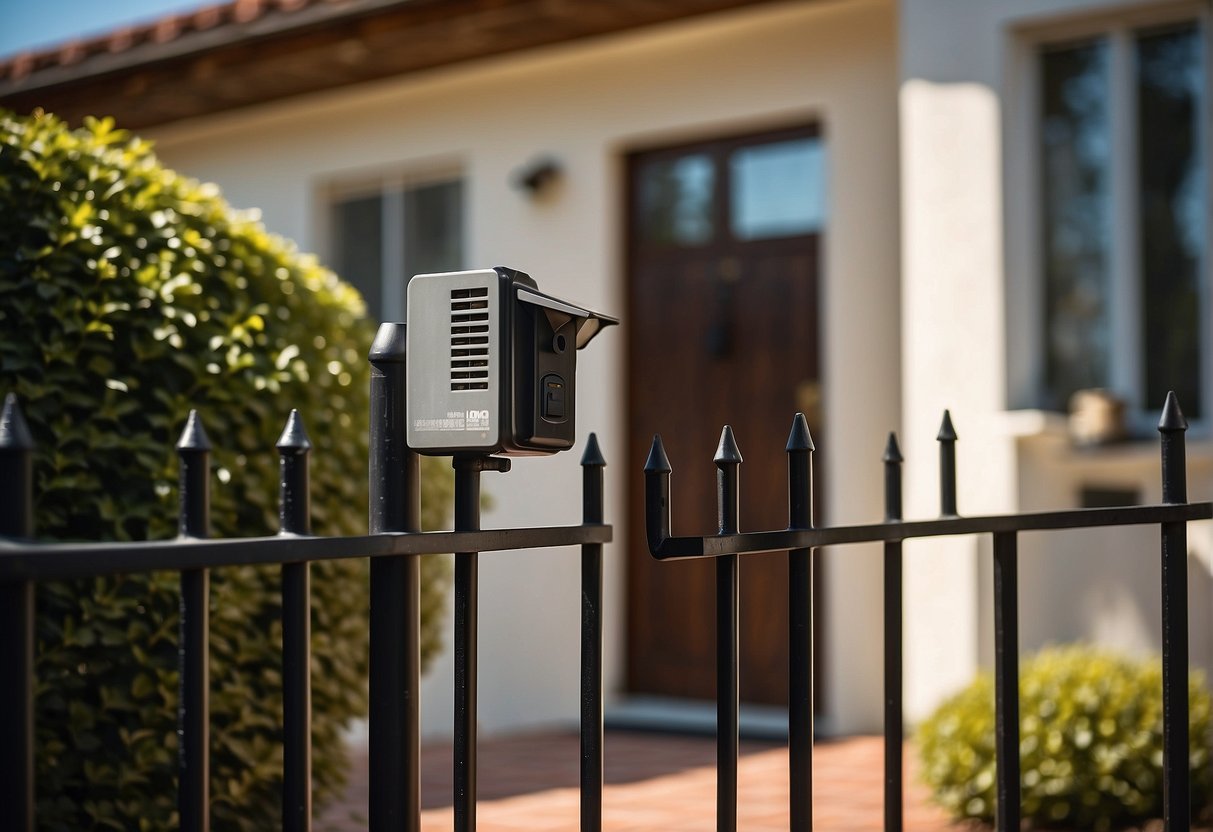
Home Safety Measures: Easy Peasy Tips for a Secure Home
Home safety is an essential aspect of keeping our living spaces secure and comfortable for everyone, particularly for older adults and families with young children. The risk of accidents, injuries, and other potential hazards can be significantly reduced by applying practical, preventive measures. Emphasizing safety awareness and incorporating tailored solutions for various household members can help in creating a safer environment for all.
Assessing home safety involves identifying potential risks, ranging from falls and fires to poison exposure and security threats. Each home’s unique layout and the needs of its occupants call for a personalized approach. It is crucial to find a balance between safeguarding the house and ensuring that everyone feels comfortable and at ease in their surroundings.
Implementing measures to protect against falls, enhancing fire prevention and response strategies, and taking necessary steps to poison-proof our homes are just a few examples of improving overall safety. Additionally, securing our homes against external threats and preparing for emergencies are essential aspects of comprehensive protection.
Key Takeaways from Home Safety Measures
- Prioritize home safety to prevent accidents and injuries, especially for older adults and young children.
- Assess potential risks and tailor home safety measures to meet the unique needs of each household.
- Focus on fall protection, fire prevention, poison prevention, and home security to create a safe living environment.
Assessing Home Safety
Fire Safety
It is crucial to have working smoke detectors installed in your home. This simple step can significantly reduce the risk of a deadly fire. In addition to installing smoke detectors, make sure you have a fire extinguisher available and a smart escape plan in place. For a compilation of essential safety rules at home, this resource can help guide you.
Fall Prevention
Falls are a prevalent home hazard, especially for older adults. To prevent falls, ensure that stairways are adequately lit and remove any tripping hazards such as loose rugs, cords, and clutter. Installing grab bars in bathrooms and non-slip mats in tubs and showers can also minimize the risk of falling.
Poison Control
To ensure proper poison control, all potentially harmful substances, including medications, cleaning products, and pesticides, should be stored in a secure location, out of reach of children. Additionally, keeping a list of emergency numbers, such as the poison control hotline, visible and accessible is vital in case of accidental ingestion.
Water Safety
Drowning accidents can happen in mere seconds, so it’s vital to install safety measures, particularly if you have a pool or live near a body of water. Pool fences, alarms, and self-closing gates are essential components of water safety. Regularly checking and maintaining these barriers is also crucial to maximize their effectiveness.
Electrical Safety
Electrical safety is an essential aspect of home safety. Ensure that all electrical cords are in good condition, and do not overload outlets. Use safety covers on unused outlets if you have young children, and unplug appliances when not in use. Investing in a home security system featuring ground fault circuit interrupters (GFCIs) can also provide an added layer of protection from electrical hazards.
Protecting Against Falls
Falls are a common household hazard, especially for older adults and small children. It’s essential to take steps to minimize the risk of falls in your home. In this section, we’ll discuss some key areas to focus on to improve safety.
Safety Gates
One simple and effective way to protect against falls is by installing safety gates. This is especially important if you have small children or elderly individuals living in your home. Install gates at the top and bottom of stairs to prevent accidental falls and to create a safe environment for all residents. Make sure the gates are sturdy and easy to operate for adults but difficult for children to open.
Grab Bars and Handrails
Grab bars are extremely helpful in preventing falls, particularly in bathrooms. Install them near toilets and inside showers to provide support and stability for older adults or anyone who may have trouble standing and maneuvering in slippery areas.
Handrails should be available on both sides of stairs to help all individuals navigate safely, as well as in hallways or other areas where someone may need extra support. Make sure these rails are sturdy and securely fastened to the wall to ensure safe and effective use.
Safe Flooring
Flooring plays a crucial role in fall prevention. To create a safer home environment, consider the following:
- Remove area rugs or secure them with non-slip pads to prevent slipping or tripping.
- Keep floors clean and dry, promptly cleaning up spills to avoid slip hazards.
- Choose flooring materials that provide good grip and traction, especially in areas prone to becoming slippery, such as bathrooms and entryways.
Furniture Placement
Thoughtful furniture placement can help reduce the risk of falls. Avoid cluttering your living spaces and ensure clear, wide pathways for easy navigation. Arrange furniture in a way that allows ample room to move around, particularly near stairs and hallways. Be mindful of potential tripping hazards, such as furniture legs, power cords, and other household items – and keep them contained or out of high-traffic zones.
By implementing these measures, you can greatly reduce the risk of falls in your home, creating a safer environment for everyone.
Fire Prevention and Response

Smoke Detectors and Alarms
Smoke detectors and alarms are essential for detecting fires early and alerting the occupants of a home. Make sure to install them on every level of your home, especially near bedrooms. Regularly test these devices and replace batteries at least once a year.
Fire Extinguishers
A fire extinguisher is a must-have tool for putting out small fires before they spread. Keep one in high-risk areas, such as the kitchen and garage. Be sure to check the expiry date, as they don’t last forever. Familiarize yourself with the PASS method for using extinguishers:
- Pull the pin
- Aim at the base of the fire
- Squeeze the handle
- Sweep side to side
Remember, though: never fight a fire that seems too large or uncontrollable. Instead, prioritize evacuating and calling for help.
Safe Cooking Practices
Many home fires are caused by cooking mishaps. Follow these simple rules for safer cooking:
- Never leave cooking unattended
- Keep your cooking area clean and free from grease
- Use a timer to remind you of what’s on the stove
- Keep flammable items away from the cooking surface
Opt for flameless candles to prevent open flames from candles causing fires.
Heating Equipment Safety
Ensure proper maintenance and use of heating equipment, such as heaters, chimneys, and fireplaces. Follow these best practices:
- Have chimneys and vents professionally cleaned and inspected annually
- Keep flammable items at least 3 feet away from heating equipment
- Use a sturdy screen in front of fireplaces to prevent embers from escaping
- Never leave space heaters on when you’re asleep or out of the room
Having an escape plan in case of a fire is critical. Make sure all family members know the plan and practice it regularly. Finally, stick to designated smoking areas outside the home, and never smoke in bed.
Poison Prevention

Medication Storage
It’s essential to properly store medications to prevent accidental poisoning. Keep them in their original containers with clear labels. Always store medications out of reach of children, preferably in a locked cabinet. This includes prescription drugs, over-the-counter medicines, and even vitamins. Remember, kids can be curious, so it’s better to be safe than sorry.
Here are a few quick tips for medication storage:
- Keep medicines in a cool, dry place
- Avoid storing them in direct sunlight or heat
- Don’t mix different medications in the same container
Household Chemicals
Many household products contain chemicals that can be harmful if ingested or improperly used. To prevent accidental poisoning, always follow these guidelines:
- Store household chemicals in a secure location away from children and pets
- Keep products in their original containers with clear labels
- Dispose of chemicals according to manufacturer’s instructions and local regulations
- Never mix different chemicals, as this can create dangerous reactions
Some common household products to keep an eye on include cleaning products, pesticides, antifreeze, and alcohol.
Carbon Monoxide Detection
Carbon monoxide (CO) is a silent killer – it’s colorless, odorless, and tasteless. CO poisoning can result from faulty appliances, blocked vents, and other sources of combustion fumes.
Investing in a carbon monoxide detector can help protect your home and family. Here are some tips for using CO detectors effectively:
- Install CO detectors on every level of your home, near sleeping areas
- Test detectors monthly and replace batteries according to the manufacturer’s recommendation
- Replace the entire CO detector unit every 5-7 years, or as specified by the manufacturer
By following these poison prevention tips, you can create a safer environment for yourself and your loved ones.
Securing the Home

Locks and Alarms
A great way to prevent burglaries is by investing in high-quality locks for your doors and windows. Deadbolts are especially effective in deterring unwanted visitors from entering your home. Additionally, installing alarms on your doors and windows can help alert you of any potential security breaches. Remember to regularly inspect and update your locks and alarms to maintain your home’s safety.
Home Security Systems
Modern home security systems offer a variety of features to keep your home secure. Besides traditional alarms, many systems now include security cameras and other monitoring devices, allowing you to keep an eye on your property at all times. Some even offer smart features, such as remote monitoring via your smartphone, giving you peace of mind even when you’re away from home. Consider researching the 10 Tips for Home Safety in 2023 to help you choose the best security system that suits your needs.
Windows and Door Safety
Windows and doors play a crucial role in your home’s overall security. Ensure that all your windows are equipped with secure locks, and consider installing impact-resistant or shatterproof glass for added protection. Window bars can also be an effective deterrent against burglaries. Moreover, having a sturdy door made of solid wood, metal, or fiberglass, paired with the appropriate locking mechanisms, can make it more difficult for intruders to gain access to your home.
Safe Storage of Valuables and Firearms
It’s essential to store valuables and firearms securely within your home. Consider investing in a fireproof safe to protect important documents, jewelry, and other valuable items. Safes should be securely bolted down, and their placement should be discreet and inaccessible to potential burglars. When it comes to firearms, ensuring that they’re stored in locked cabinets or safes is crucial, preventing unauthorized access or accidents. Proper storage can help minimize the risk of theft and keep your home and family safe.
Preparing for Emergencies

Emergency Contact Numbers
It’s essential for everyone to have a list of emergency contact numbers readily available. This list should include 911, the universal emergency number for the United States, and the local poison control center. In addition, consider adding the phone numbers of trusted neighbors, family, and friends who can offer a helping hand. Keep this information in an easily accessible place, such as on the fridge or near the home phone.
Disaster Readiness
Preparing for disasters involves more than just having emergency supplies on hand. Families should create and practice an escape plan tailored to their home. Create a map detailing various escape routes, including a fire escape plan if applicable. Discuss and rehearse this plan with all household members, making sure everyone knows what to do in case of an emergency.
Here are a few simple steps to prepare for disasters:
- Know the types of emergencies common to your area.
- Create and practice escape plans for various scenarios.
- Assemble an emergency kit with essential items such as food, water, and critical medications.
- Have an emergency communication plan ready.
First Aid Supplies
One cannot stress enough the importance of having a well-stocked first aid kit at home. First aid supplies like bandages, adhesive tape, scissors, antiseptic, and pain relievers can be invaluable during emergencies. Additionally, it’s a good idea for at least one family member to be knowledgeable in basic first aid procedures to handle injuries while waiting for professional help.
Below is a table of essential items to include in your first aid kit:
| Item | Quantity |
|---|---|
| Adhesive bandages | 20-25 |
| Gauze rolls | 2-3 |
| Antiseptic wipes | 10-15 |
| Adhesive tape | 1 roll |
| Scissors | 1 pair |
| Pain relievers | As needed |
| Tweezers | 1 pair |
| Disposable gloves | 1-2 pairs |
| Instant cold pack | 1-2 |
Remember, emergencies can happen at any time. By taking these preventative measures and following the guidelines above, one can ensure their household is well-prepared for the unexpected.
Special Considerations

Children’s Safety
When it comes to children’s safety, it’s essential to take special precautions to protect the little ones. First, consider installing safety gates at the top and bottom of stairs to prevent accidents. Next, pay attention to lighting by ensuring that rooms and walkways are well-lit for easy navigation.
Additionally, keep an eye out for potential hazards like small objects that could lead to choking incidences. Here’s a quick list of measures to keep in mind:
- Use safety gates for stairs
- Ensure proper lighting
- Remove choking hazards
- Secure furniture to prevent tipping
Elderly Care and Safety
Elderly care and safety are crucial for older adults who may be at greater risk of injury due to limited mobility and weakening senses. Providing proper lighting and installing grab bars in bathrooms can help reduce the risk of falls for seniors.
To further enhance elderly safety, consider these tips:
- Use non-slip mats to minimize slipping hazards
- Provide walking aids like a cane or walker
- Keep common areas clutter-free and organized
- Install grab bars in bathrooms for added support
Pet Safety
Last but not least, pet safety requires special consideration too. Ensure that your furry friends have a designated space in your home, free from hazards. Here are some pet safety tips:
- Keep electrical cords and wires out of reach
- Store cleaning supplies and chemicals safely
- Use pet-friendly houseplants, avoiding toxic varieties
By following these guidelines, you can create a safe environment for children, seniors, and pets in your home. Remember, staying proactive and diligent about home safety can make all the difference.
Safety Awareness and Education

Home safety is crucial for creating a secure environment for the whole family. Being aware of potential hazards and taking appropriate measures can prevent accidents and injuries. In this section, we’ll discuss some essential safety tips, resources like poison control, and how professionals like occupational therapists contribute to home safety.
To ensure a safer home, consider the following safety tips:
- Install smoke alarms and carbon monoxide detectors.
- Keep a fire extinguisher readily accessible.
- Secure heavy furniture and appliances to prevent tip-overs.
- Avoid overloading electrical outlets and replace worn-out cords.
- Put non-slip mats in bathtubs and showers.
- Keep the floors free from clutter, minimizing tripping hazards.
- Store hazardous materials and medications securely and out of children’s reach.
- Implement a home escape plan in case of emergencies.
When it comes to handling dangerous substances, poison control is a valuable resource. The Centers for Disease Control and Prevention (CDC) recommends keeping the Poison Help hotline (1-800-222-1222) accessible in case of exposure to poisonous substances. You can also visit their website to learn more about poisoning prevention and treatment.
Seeking advice from an occupational therapist can further enhance home safety. These professionals evaluate a person’s living environment, identify areas for improvement, and suggest modifications, such as installing grab bars, modifying lighting, or rearranging furniture. They can provide personalized recommendations based on a family’s specific needs and abilities, ensuring a safer and more accessible living space.
In conclusion, maintaining safety awareness and receiving education on home safety best practices can significantly reduce the risk of accidents and injuries. By implementing appropriate measures, utilizing available resources, and engaging professionals like occupational therapists, you can create a safer home for everyone.
Luxury Specialist at McGraw Realtors
With a diverse background, including a career as an Air Force fighter pilot and entrepreneurship, Bill transitioned to real estate in 1995. Co-founding Paradigm Realty with his wife, Charlene, he quickly rose to prominence in Oklahoma City’s luxury real estate scene. Now, as one of the top agents with annual sales surpassing $20 million, Bill’s dedication to exceptional service remains unparalleled. With a legacy spanning over two decades in the industry, Bill’s expertise and commitment make him a trusted name in luxury real estate.